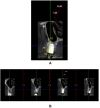Radiographic and Esthetic Evaluation Following Immediate Implant Placement with or without Socket Shield and Delayed Implant Placement Following Socket Preservation in the Maxillary Esthetic Region - A Randomized Controlled Clinical Trial
- PMID: 34824552
- PMCID: PMC8610775
- DOI: 10.2147/CCIDE.S332687
Radiographic and Esthetic Evaluation Following Immediate Implant Placement with or without Socket Shield and Delayed Implant Placement Following Socket Preservation in the Maxillary Esthetic Region - A Randomized Controlled Clinical Trial
Abstract
Objective: The purpose of this study was assessment of the changes in soft and hard tissues in the esthetic zone of maxilla following immediate implant placement (IIP) with and without the socket shield technique (SST) and placement of implants 4 months following socket preservation (DIP) in terms of alterations in crestal bone thickness (CBT) and soft tissue changes evaluated by means of pink esthetic scores (PES) following placement of implants in the esthetic zone of maxilla.
Materials and methods: In the maxillary esthetic region, 75 dental implants were placed totally, with 25 implants each in the SST, IIP, and DIP groups. All participants were subjected to undergo CBCT for assessing the variations in thickness of crestal aspect of facial/buccal/labial alveolar bone (CBT). PES and PROMS (patient-related outcome measures) were assessed using VAS for pain threshold and esthetic satisfaction following implant placement and after 6th post-operative month.
Results: The mean reduction in CBT showed a statistically significant difference between and within the groups, in comparison to IIP and DIP groups, which demonstrated an average reduction in CBT 0.4 ± 0.1 and 0.2 ± 0.1 at 6 months following implant placement, respectively. The SST group showed a significantly lesser reduction in CBT of 0.05 ± 0.02. However, the mean difference in PES within and among the groups showed no significant difference statistically at P < 0.05. On comparison of individual scores of PES between the groups, the results showed significant difference statistically at P < 0.001.
Conclusion: The SST group demonstrated minimal reduction in CBT and a superior PES at the end of 6 months compared with the IIP and DIP groups.
Keywords: immediate implant placement; pink esthetic score; randomized controlled trial; socket preservation; socket shield technique.
© 2021 Santhanakrishnan et al.
Conflict of interest statement
The authors report no conflicts of interest in this work.
Figures








References
Publication types
LinkOut - more resources
Full Text Sources

